|
 Obesity may be defined as a condition in which there is an
excess amount
of body fat. It is the most common form of malnutrition in the Western
world. Obesity is the net result of an excess of energy consumption over expenditure. Factors that must be considered as contributing to causation are: heredity, overeating, altered metabolism of adipose tissue, defective or decreased thermogenesis (the process by which calories are converted to heat), decreased physical activity without an appropriate reduction in food intake, and certain prescribed medications. Obesity may be defined as a condition in which there is an
excess amount
of body fat. It is the most common form of malnutrition in the Western
world. Obesity is the net result of an excess of energy consumption over expenditure. Factors that must be considered as contributing to causation are: heredity, overeating, altered metabolism of adipose tissue, defective or decreased thermogenesis (the process by which calories are converted to heat), decreased physical activity without an appropriate reduction in food intake, and certain prescribed medications.
Excess abdominal fat is an independent predictor of disease risk. A waist circumference of over
35 inches in women signifies increased risk in those who have a
BMI of 25 to
34.9
Our main energy store is fat, an energy intake greater than energy expenditure unavoidably causes an increase of adipose tissue, which is always accompanied by an increase of lean body mass, and thus an increase of body weight.
Since body energy expenditure is proportional to body weight, an increase of the latter also causes an increase of energy expenditure. The body weight will then stabilize when the energy expenditure of the weight gain will equal the increase of energy intake, the balance condition being
re-established. Exactly the opposite happens if the energy intake is permanently reduced.
|
Failure does not count. If you accept this, you'll be successful. What causes most people to fail is that after one failure, they will stop trying.
--Frank Burford-- |
Level of physical activity : There are patient who reports a history of progressive lifelong weight gain with no progressive lifelong increase in food intake. Moreover, it is quite possible that the energy intake has actually remained the same, the progressive weight gain being caused by decreased energy expenditure due either to the progressive reduction of physical activity that generally accompanies weight gain
Aging
:The progressive reduction of lean body mass which inevitably occurs with
aging causes increase in weight due to fall in the body's capacity to burn fat. The
physiological loss of lean body mass that occurs with aging, if the energy intake remains the same, compulsorily causes the gain of a body weight which, as we know, is composed of lean and fat, and thus consumes less and must be gained in a greater amount to produce the same consumption of what was lost.
Body Composition: Individuals with equal body weight may have different energy intakes, and individuals with the same energy intake may have different body weights, and
a very heavy individual may have an energy intake much smaller than that of another much lighter individual, and vice versa. In summary, certainly the energy intake determines body weight and its variations, but the size of body weight and of its variations is determined by body composition and by its variations.
Genetic factors: Obesity
tends to run in families, suggesting a genetic cause. The mechanism through
which genetics might effect weight gain include reduced dietary-induced thermogenesis,
lower Resting Metabolic Rate, decreased thyroid functioning, decreased lipoprotein
lipase activity, lower Basal body temperatures and decreased amount of more
metabolically active brown fat. Families also share
diet and lifestyle habits that may contribute to obesity. Separating these from
genetic factors is often difficult. Even so, science shows that heredity is
linked to obesity.
Socio-economic
: In affluent countries obesity is more common in the lower socio-economic
groups. In developing countries it occurs in the prosperous elite. Society too
carries its pressure on individuals to either be too thin (model-like) or
fat as a sign of prosperity.
Lifestyle behaviors
- such as what a woman eats.
Americans tend to eat high-fat foods, and put taste and convenience ahead of nutrition. Although
you cannot change your genetic makeup, you can change your eating habits.
Psychological
factors may also influence eating habits. Many people eat in response to
negative emotions such as boredom, sadness, or anger. Most overweight people have no more psychological problems than people of average
weight. Still, up to 10 percent of people who are mildly obese and try to lose
weight on their own or through commercial weight loss programs have binge eating
disorder. This disorder is even more common in people who are severely obese.
During
a binge eating episode, people eat large amounts of food and feel that they
cannot control how much they are eating. Those with the most severe binge eating
problems are also likely to have symptoms of depression and low self-esteem.
These people may have more difficulty losing weight and keeping it off than
people without binge eating problems. If you are upset by binge eating behavior
and think you might have binge eating disorder, seek help from a health
professional such as a psychiatrist, psychologist, or clinical social worker.
Endocrine
factors : An endocrine influence on body fat is seen both in normal
physiological situations and in pathological state. The normal fat content of
young adult women is about twice that of young men and pregnancy is
characterized by an increase in body fat. Obesity in women begins at puberty,
during pregnancy or at menopause. Obesity frequently but not invariably,
accompanies hypothyroidism, hypogonadism, hypopituitarian and Cushing's Syndrome.
Other
causes of obesity
Some illnesses can lead to obesity or a tendency to gain weight.
These include depression, and certain
neurological problems that can lead to overeating. Also, drugs such as steroids,
oral contraceptives, phenothiazines, insulin and some antidepressants may cause
appetite stimulation & consequently weight gain. A doctor can tell whether there
are underlying medical conditions that are causing weight gain or making weight
loss difficult
|
If you have a slice of
pie you can always hop back on the bandwagon immediately. There is no
use in calling it quits over a small defeat. Eating the slice of pie is
not failure - it is a minor setback. It is getting knocked down. but
when you don't pick yourself up and keep going - that IS FAILURE! If you
let one tiny defeat keep you down - you are a failure. But if you keep
going - YOU HAVE AND WILL SUCCEED FOR SURE! You just remember that, darn
it! No matter what happens you can keep driving along. DO NOT
QUIT!!!!!!!! |
In most cases the diagnosis will be apparent from the woman's
appearance but the degree of obesity should be assessed, by using the Body-Mass
Index. In addition the skin-fold thickness over the triceps muscle can be
measured using special spring loaded calipers. Obesity is indicated by a
measurement of more than 28mm in women.
Mechanical Disabilities
associated with Obesity are listed below:
Metabolic disorders: Non-insulin dependent diabetes
mellitus, hyperlipidaemia, gall stone, hyperuricaemia, and gout are more common
among the obese than in general population.
Cardiovascular Disorders
: Obesity increases the load on
the heart, which enlarges with rising body weight. Cardiac output, stroke
volume, and blood volume also increases. Higher Blood Pressure is often reported.
Life Expectancy : Overweight is associated with an
increased rate of mortality at all ages. However the degree of mortality varies
more or less in proportion to degree of obesity.
Several
serious medical conditions have been linked to obesity, including type 2
diabetes, heart disease, high blood pressure, and stroke. Obesity is also linked
to higher rates of certain types of cancer. Obese women
are more likely than non-obese women to die from cancer of the gallbladder,
breast, uterus, cervix, or ovaries.
|
Listed
below are the diseases and health problems linked to obesity :
-
Gallbladder
disease and gallstones.
-
Liver
disease.
-
Osteoarthritis,
a disease in which the joints deteriorate. This is possibly the result of
excess weight on the joints.
-
Gout,
another disease affecting the joints.
-
Pulmonary
(breathing) problems, including sleep apnea in which a person can stop
breathing for a short time during sleep.
-
Reproductive
problems in women, including menstrual irregularities and infertility.
|
Health
care providers generally agree that the more obese a person is, the more likely
he or she is to develop health problems.
Psychological
and social effects
Emotional
suffering may be one of the most painful parts of obesity. American society
emphasizes physical appearance and often equates attractiveness with slimness,
especially for women. Such messages make overweight people feel unattractive.
Many
people think that obese individuals are gluttonous, lazy, or both, even though
this is not true. As a result, obese women often face prejudice or
discrimination in the job market, at school, and in social situations. Feelings
of rejection, shame, or depression are common.
|
Positive self talk
needs to be at the top! Throw out those bad thoughts! Just stop and ask
yourself one simple question. Would you say those things to a friend or
a child? Then why, oh why, do you say those horrible, degrading things
to yourself!? Rule number one is stick to positive reinforcements when
it comes to the way you treat yourself! This may well be the hardest
aspect to losing weight, so please let us help you and check out the
support board! |
According to the guidelines, the most successful strategies for weight loss include calorie
reduction, increased physical activity, high carbohydrate and fiber content in
diet, palatable food choices, decreased fat consumption and behavior therapy designed to improve eating and physical activity habits. Other recommendations include:
-
Engage in moderate physical activity, progressing to
30 minutes or more on most or preferably all days of the week. Choose
a low impact exercise such as
walking,
swimming
or
cycling, avoid
high-impact aerobics. Besides, begin at low intensity just enough to get
your muscles accustomed to moving. Once regular slowly build up on duration
by 5-10 min per session. Try to exercise for a longer duration rather than
increasing the pace to burn fat. Don't count the scale to tell you the
whole story, for muscle weigh more than fat, you may be getting fitter and
thinner without corresponding loss of pound.
-
Reducing dietary fat alone--without reducing
calories--will not produce weight loss. Cutting back on dietary
fat
can help reduce calories and is heart-healthy. Foods
high in fat and sugar such as cakes, puddings, cream, chips, pies,
mayonnaise and butter need not be banned, but should not become a part of
your daily diet. Instead eat more vegetables, fruits, wholegrain, and
pulses which are filling nutritious but not fattening.
produce weight loss. Cutting back on dietary
fat
can help reduce calories and is heart-healthy. Foods
high in fat and sugar such as cakes, puddings, cream, chips, pies,
mayonnaise and butter need not be banned, but should not become a part of
your daily diet. Instead eat more vegetables, fruits, wholegrain, and
pulses which are filling nutritious but not fattening.
-
Resistance
training has been found to significantly increase the Resting
Metabolic Rate (RMR) and Fat-Free Mass (FFM) in sedentary elderly women.
Therefore a personalised
Strength
Training Programis essential component of a weightloss program.
-
The initial goal of treatment should be to reduce body weight by about 10 percent from baseline, an amount that reduces obesity-related risk factors. With success, and if warranted, further weight loss can be attempted.
-
A reasonable time line for a 10 percent reduction in body weight is six months of treatment, with a weight loss of 1 to 2 pounds per week.
-
Weight-maintenance should be a priority after the first 6 months of weight-loss therapy.
-
Physicians should have their patients try lifestyle therapy for at least 6 months before embarking on physician-prescribed drug therapy. Weight loss drugs approved by the FDA for long-term use may be tried as part of a comprehensive weight loss program that includes dietary therapy and physical activity in carefully selected patients (BMI >30 without additional risk factors, BMI >27 with two or more risk factors) who have been unable to lose weight or maintain weight loss with conventional
non-drug therapies. Drug therapy may also be used during the weight maintenance phase of treatment. However, drug safety and effectiveness beyond one year of total treatment have not been established.
-
Weight loss surgery is an option for carefully selected patients with clinically severe obesity -- BMI of > 40 or BMI of >35 with coexisting conditions when less invasive methods have failed and the patient is at high risk for obesity-associated illness. Lifelong medical surveillance after surgery is a necessity.
-
Overweight and obese patients who do not wish to lose weight, or are otherwise not candidates for weight loss treatment, should be counseled on strategies to
avoid further weight gain.
-
Age alone should not preclude weight loss treatment in older adults. A careful evaluation of
potential risks and benefits in the individual patient should guide management.
According to NHANES III, the trend in the prevalence of overweight and obesity is upward. The guidelines note that from 1960 to 1994, the prevalence of obesity in adults (BMI >30) increased from nearly 13 percent to 22.5 percent of the U.S. population, with most of the increase occurring in the 1990s.
The guidelines have been reviewed by 115 health experts at major medical and professional societies. They have been endorsed by the coordinating committees of the National Cholesterol Education Program and the National High Blood Pressure Education Program, the North American Association for the Study of Obesity, the NIDDK Task force on the Prevention and Treatment of Obesity, and the American Heart Association.
-
SAMPLE
MENUS /1200 CALORIES
This
reducing diet is suitable for non pregnant women. The amount of
weight you'll loose depends on the difference between your previous
calories intake and the diet.
-
SAMPLE
MENUS /1800 CALORIES
This
menu is suitable for many mature women. each days menu illustrates
four principles of low fat eating.
-
select
lower fat milk products
-
Select
lean, lower fat meat: Removes skin from poultry and trim excess
fat from meat.
-
Use
low fat food preparation methods.
-
Reduce
the amounts of fats added at the table.
|
An hour's walk at 3
miles per hour will expend about 240kcal above Basal (or more for a
heavy person). This may seem a small amount, equivalent to about 30g
of body fat, but if your daily walk becomes a habit it will add up,
other things being equal, to a weightloss of 10 kg in a year. |
Drug therapy
: This is no substitute for a
dietary regime.
-
Amphetamine-like drugs with similar anorectic properties may be given for
short period say about a month to help attain short-term goals. They should
not be taken by patients with hypertension & coronary heart disease.
-
Orlistat, which acts on the intestinal tract to prevent the absorption of
about 30 % of ingested fat.
One thing all these drugs have in common is while they facilitate 10 % loss
in body weight, the weight rapidly returns once the drugs are discontinued.
|
FDA-Approved Medications for Treating Obesity:
|
Weight-loss medications may be recommended for
patients who are at increased medical risk because of their obesity. Most
research-based and professional associations recommend lifestyle therapy for at
least six months before embarking on a weight-loss plan using
physician-prescribed drug therapy. Even then, it must be used only as part of a
comprehensive weight loss program that includes dietary therapy and physical
activity. Currently available prescription medications include:
* Phentermine (Adipex, Fastin, Ionamin, Oby-trim)
* Diethylpropion (Tenuate, Tenuate dospan,
Tepanil)
* Mazindol (Sanorex, Mazanor)
* Phendimetrazine (Adipost, Bontril, Plegine,
Prelu-2, X-Trozine)
* Benzphetamine (Didrex)
* Sibutramine (Meridia)
* Orlistat (Xenical)
Most of these appetite-suppressants have been
approved for short-term use, meaning a few weeks or months. Sibutramine and
orlistat are the only weight-loss medications approved for longer-term use in
significantly obese patients, although the safety and effectiveness have not
been established for use beyond one year. Most of these drugs decrease appetite
by affecting levels of the brain neurotransmitters catecholamine, serotonin
and/or noradrenaline -- brain chemicals that affect mood and appetite. Orlistat
(Xenical) does not act directly on the central nervous system but inhibits an
enzyme essential to fat digestion. In general, these medications are modestly
effective, leading to an average weight loss of five to 22 pounds above that
expected with non-drug obesity treatments.
If you are, may be or could become pregnant or
are nursing, be sure to tell your healthcare professional. The effects of most
of these drugs have not been tested on unborn babies; however, medications
similar to some of the short-term appetite-suppressants have been shown to cause
birth defects when taken in high doses. Also, diethylpropion and benzphetamine
pass into breast milk.
You also will need to tell your health care
professional about any existing medical problems before taking these
medications, especially thyroid problems, anxiety disorders, epilepsy or other
seizure disorders, diabetes, heart disease, high blood pressure,
arteriosclerosis, or glaucoma. Also, your healthcare professional needs to be
aware of any other medications you are taking or have taken within the last 14
days, especially monoamine oxidase inhibitors (MAOIs) such as isocarboxazid (Marplan),
tranylcypromine (Parnate), or phenelzine (Nardil). Mention any existing or
previous problems with alcohol or drug abuse as well. Side effects of
anti-obesity drugs can range from mild to serious and should be discussed in
detail with your health care professional before making a decision to use these
medications.
Surgical treatment :
For clinically severe obesity, surgery may be an element of treatment. Many
people, some physicians included, wrongly believe that obese people merely need
to stop eating so much and they will lose weight. In reality, severe obesity
is a potentially deadly disease that sometimes requires a treatment as dramatic
as surgery.
There are two types of obesity surgery — restrictive
and combined restrictive/mal-absorptive.
Different ways of performing each surgery have been developed. Each type of
surgery has its own risks and side effects. Your physician can help you decide
which is best for you.
Wiring the jaws together to
prevent eating has been used to treat those who have found it impossible to
adhere to low-energy diet. These can help patients to achieve remarkable
weightloss, but most patients regain weight when the procedure is reversed. Another major surgery involves the reduction in size of the
stomach for example by stapling which can be undone. Small intestine bypass
aimed at inducing mal-absorption, has been undertaken in some centers for
treatment of severe "morbid" obesity but complications can be severe
and sometimes fatal. Surgery should be considered only for those with gross,
intractable obesity. To know more about the various surgical procedures log on
to http://www.medscape.com.
NOTE:
Successful weightloss does not depend on operation, drugs, injections, fad diets or
other manipulation undertaken by the therapist, rather it depends on the ability
of the patient to manage the disorder herself and to persist indefinitely with
some restrictions on dietary freedom.
For more easy to understand
guidelines:
Recent
News:
-
Bigger Family, Bigger
Waistline?(September 21,
2004)
-
Doctors Ignoring Obesity
Problem(August 5,
2004)
-
Abdomen fat Linked to
Hypertension (June 21,
2004)
-
Is
it Asthma, or Just the Weight?
(June 11,
2004)
-
Low-carb Better than Low-fat? (May 19, 2004)
-
Who Pays in the Obesity Battle? (March 29, 2004)
-
Obesity Linked to Type 1 Diabetes
(October 09, 2003)
-
Obesity not Related to
Cancer Recurrence
(October 03, 2003)
-
A Possible Cause for Obesity
(September 4, 2003)
-
Obesity Increases Risk of
Cervical Cancer
(September 10, 2003)
-
Born to be Overweight?
(August 15, 2003)
-
Obesity
Hurts and Helps Colon Cancer Patients
(August 5, 2003)
-
Obesity Linked to Alzheimer’s
(July
28, 2003)
-
Coping with Weight Loss
(2 June. 2003)
-
Diabetic Women On
Hormone Replacement Therapy Have Better Glycemic And Lipid Profiles.
(26 Sept. 2002)
-
Fighting
Fat One Step at a Time (
Feb. 7, 2003)
-
One
in 13 deaths in Europe due to excess weight (Feb. 13, 2003)
Related
Articles:
|
|
Smart Tip |
 |
|
Accept that
losing weight will be a long term process. Aim to lose 1-2
lbs/week. There is no miraculous crash diet to take off large
amounts of weight in few days. |
| |
|
 |
| |
| |
|

Download
Printable Version |
| |
|
Latest Article |
|
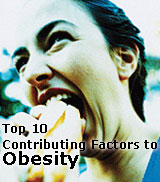 |
|
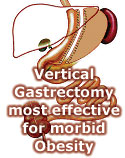
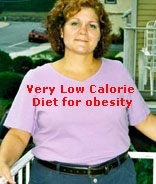
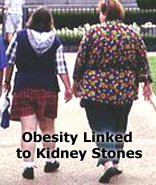


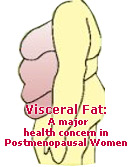
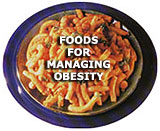
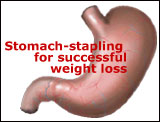
|
|
 |
|
|
|
|
|
Smart Tip |
 |
|
Eating
should always be a pleasurable experience and the best
way to lose weight is to choose a diet that you enjoy an
is one that fits into your way of life. |
|
|
|
|
|
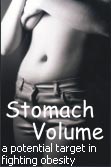 |
|
|
|
|
|
|
|
 |
 |
|
Body fat has been linked to postmenopausal
breast cancer because of its effect on estrogen levels. Although the
ovaries stop producing estrogen after menopause, fat cells continue to
pump the hormone into the blood stream.
|
|
|
|
|
|
 |
|
|
|
|
|
|
|
Smart Tip |
 |
|
Regular
exercise increases Resting Energy Expenditure (REP) and fat
oxidation contributing to negative energy balance which helps
preserving Lean Body Mass. |
|
|
|
|
|
|
|
Smart Tip |
 |
|
High
Blood Pressure is associated with obesity. For every 10
kg increase in body weight, there will be a 3mmHg rise
in Systolic & 2mm Hg rise in diastolic pressure. |
|
|
|
|
|
|
|
Smart Tip |
 |
|
If
you find it difficult to lose weight and keep it off,
don't despair. It may actually be healthier to maintain
a weight slightly above recommended for you than to lose
& regain extra pounds in an endless -and- stressful
cycle. |
|
|
|
|
|
|
|
Smart Tip |
 |
|
Calorie
Intake should be adjusted to allow for a safe rate of
weightloss- 1 lb/week. |
|
|
|
|
|
|
|
Smart Tip |
 |
|
Do
not consume a diet less than 1,200cal/day. 30% of the
energy should come from fat,15 % from protein, and 35%
from carbohydrates. |
|
|
|
|
|
|
|
Smart Tip |
 |
|
The
body's metabolism remains significantly elevated for
10-15 minutes after a bout of exercise. |
|
|
|
|
|
|
|
Smart Tip |
 |
|
Appetite
- suppressing drugs are not a long term solution and
have many side effects. Drugs like Amphetamines have a
disadvantage of disturbed sleep, depression, and weight
gain when you eventually stop taking them. Besides they
can be addictive. |
|
|
|
|
|
|
|
Smart Tip |
 |
|
Low-
calorie formula diets should only be used in a program
of lifestyle modification, designed to increase physical
activity, reduce consumption of dietary fat &
improve coping skills. |
|
|
|
|
|
|
|
Smart Tip |
 |
|
Eat
only when you are genuinely hungry, not just because its
lunch or dinner time. |
|
|
|
|
|
|
|
Smart Tip |
 |
|
Weight loss surgery is typically reserved for those individuals 100 pounds or more overweight (Body Mass Index [BMI] of 40 or higher) who have not responded to other less invasive weight loss therapies such as diet, exercise, medications, etc. For more
information
click here. |
|
|
|
|
|
|
|
Smart Tip |
 |
|
Your
diet should contain plenty of green vegetables &
fruits, since they contain few calories,while their bulk
helps to fill the stomach and relieve hunger; they also
minimize the constipation common with low food intake. |
| |
| |
|
|
|
Smart Tip |
 |
|
Diet
pills based on bran and other types of fibre that swell
up when eaten may make you feel full, but will not burn
extra fat. Infact they have been known to cause blockage
in the throat & intestines if consumed in inadequate
quantities of liquids. |
|
|
|
|
|
|
|
Smart Tip |
 |
|
Women
following a Very Low Calorie Diet ( VLCD) need to remain
on continual medical support. |
|
|
|
|
|
|
|
Smart Tip |
 |
|
Dyslipidemia
obesity results in the elevation of Total cholesterol,
LDL cholesterol and triglyceride. |
|
|
|
|
|
|
|
|
|
Smart Tip |
 |
|
Do
not combine eating with activities- such as reading or
watching television- it is easy to eat too much without
noticing. |
| |
| |
| |
|
Smart Tip |
 |
|
Dieting
particularly low fat dieting, has been found to increase
the formation of gallstones in some individuals. So
watch out dieters. |
| |
| |
| |
| |
|
Smart Tip |
 |
|
Before
you embark on a reduced calorie diet, buy a calorie
-counter book and an accurate set of kitchen scales and
keep a written record of everything you eat. |
| |
| |
| |
|
|
 |
|